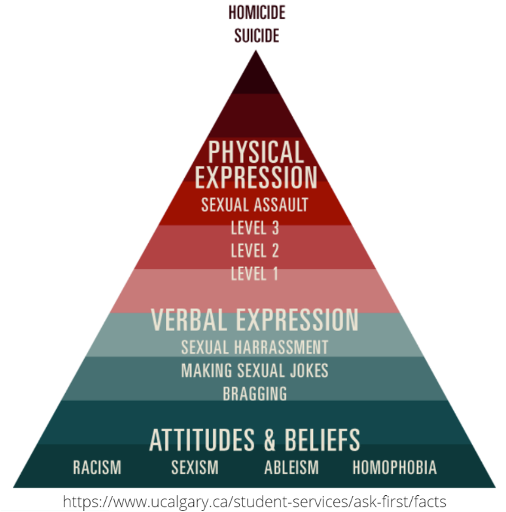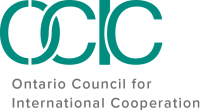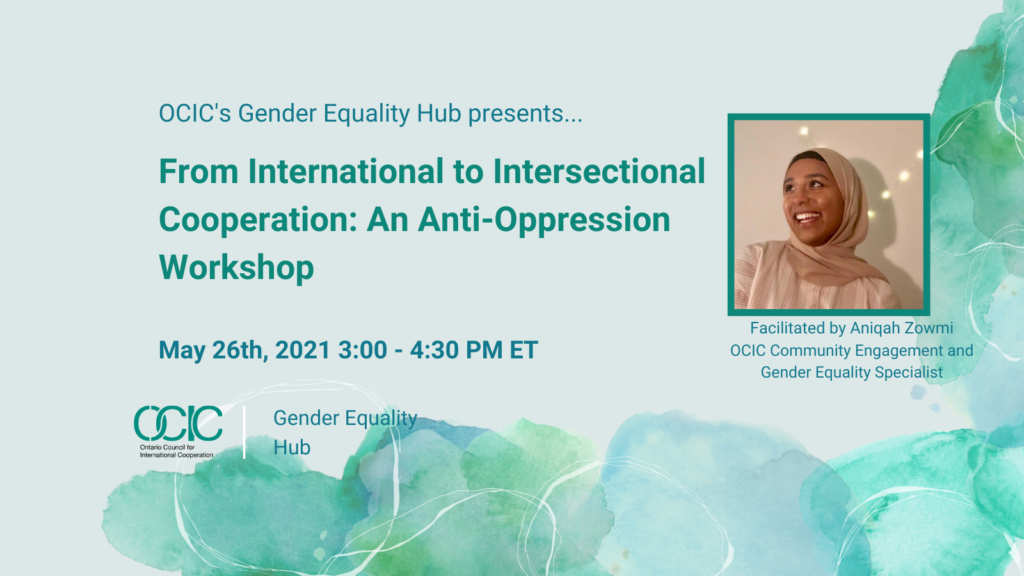
Anti-Oppression
By Neha Shrestha | July 7, 2020
OCIC’s Gender Equality Hub is a Community of Practice that seeks to actively examine how a gender transformative and intersectional approach to development can shape our work towards universal sustainable development, and how we can work together to identify gaps and challenges and mobilize around current opportunities. As part of the programming for the Hub, OCIC coordinates training sessions on topics related to gender equality that are of relevance to the sector. In this reflection, OCIC’s Gender Equality Hub Lead Volunteer, Neha Shrestha, shares her thoughts on one of OCIC’s capacity-building trainings.
On May 26, 2021, OCIC hosted a webinar titled “From International to Intersectional Cooperation: Anti-Oppression Workshop” as part of its Gender Equality Hub. The session was presented by OCIC’s Community Engagement and Gender Equality Specialist Aniqah Zowmi. To preface the key takeaways of the webinar, I would like to share three policies that OCIC has developed over the years: Anti Oppression Policy, Anti Oppression monitoring Framework, and Women’s Rights and Gender Equality Policy. These policies provide direction to the affairs of OCIC at governance, management, and operational levels.
I was personally looking forward to this webinar, as I am still educating myself about anti-oppression as a concept in international development despite having spent almost a decade in the field. Below are some of my key takeaways from the webinar. I invite you to watch the webinar here.
What does oppression mean? Why is it important to define this term? Why is it important to understand the difference between various terminology? Aniqah points out that we need to understand the language so that we can effectively dismantle the system. We are better able to explicitly point out individual instances and talk through how they fit in a system of oppression when we can identify it. It is important to understand the language, the definition, and the differences between terminology. If we do not understand the language, we cannot effectively work to be anti-oppressive.
Hence, let us start by unpacking the definition of oppression. As defined in OCIC Anti Oppression Policy, oppression is the use of power or privilege by a socially, politically, economically, or culturally dominant group (or groups) to disempower (take away or reduce power) and marginalize silence, or otherwise subordinate another social group or category. Anti-oppression is the work of actively challenging and removing oppression perpetuated by power inequalities in society, both systemic oppression and individual expression of oppression. It is actively opposing the beliefs, actions, prejudices, and systems that lead to systemic injustice.

Oppression doesn’t manifest immediately. I liked how Aniqah references the Pyramid of Violence from the University of Calgary’s Student Services to show how sexual violence doesn’t display immediately at a physical level, but it builds on the previous levels. At the pyramid base are attitudes and beliefs that position an individual as superior to another person. When this individual is surrounded by a peer group, family or society that normalizes these attitudes and beliefs, this individual will feel comfortable moving up the pyramid to verbal expression that can present itself as sexual harassment. Again, if this behaviour is normalized, it reaches physical manifestation, leading to homicide or suicide. This individual’s behaviour is an ongoing build-up that depends on the lower level of the pyramid. It is essential to intervene and dismantle the system at the bottom levels, just as it is crucial to intervene on other more visible levels. Although most people may act on their attituds and belifs throughmore horrific and visible events such as sexual assault and other physical manifestations of oppression, the lower levels are equally important to address in anti-oppressive work. This pyramid recognizes that individual acts of oppression are not random or unpredictable, and points to a larger system that enables their build-up over time.
The next model that I thought put it into perspective for me was the Staircase of Oppression. This staircase has stereotypes, prejudice, discrimination, and oppression on the four steps. Like the pyramid, each step builds on the previous step; if stereotypes are normalized, then it moved up to prejudice and ultimately to oppression. Stereotypes (positive or negative) are beliefs that people hold about others, typically founded on ignorance and that are not validated. Prejudice is when stereotypes start to manifest negatively without ever having interacted or experienced in a way that validates the belief. The next step is discrimination. Discrimination is when people are being treated differently because of their identity. This can manifest in words, actions, attitudes, and the type of people you choose to surround yourself with. And when discrimination starts to be codified in our society through policies and practices, it moves towards oppression. While discrimination can exist or typically exists on the individual level, oppression can manifest in individual interaction, but only if that interaction or the justification for the interaction falls within the larger systemic injustice. It is important to understand that this progression builds up over time and across generations, and thus the work to dismantle oppression is multi-layered and complex.
Our responsibility as international development workers
It is important to understand the concept of social location, which refers to the position an individual holds in society based on the systems of power and value that are reinforced by that system. It informs us when it is appropriate to speak to the issues and where it is appropriate to leverage our privilege to create more conversation. Since our social locations influence the way we can approach the work, it is important to reflect on all the intersecting identities that you hold as an individual in terms of race, class, religion, ethnicity, sexuality, and gender. How do you identify? – look at the social identity wheel on the right.
In the international cooperation sector, there is much work to be done to ensure that oppression is not passed on to the next generation. International development organizations can take large steps toward mitigating oppression, and as Aniqah says, ‘we have the power in this position of leadership to change the rhetoric or the context of the sector.’ However, these steps must be deliberate and informed by concepts like the social location and staircase of oppression, because there is the sinister potential of accidentally perpetuating oppression as a consequence of ignorance or inaction.
As a sector, we can equip ourselves with tools to effectively take part in working towards anti-oppression in our own work. The webinar introduces three operation frameworks – Intersectionality, Anti-Racism, and Anti-Oppression (described below). Aniqah outlines the specific questions that each of these frameworks present within the international development sector, highlighting that these frameworks can be applied widely in organizational work, and should inform all future activities to the greatest extent possible.
OPERATIONAL FRAMEWORKS
Intersectionality
A framework that looks at the different, intersecting ways that identity privileges (or disenfranchises) individuals.
Anti-Oppression
A framework that aims to mitigate and reduce the effects of systemic hierarchies, however they may manifest (race, ability, gender, sexual orientation, etc.)
Anti-Racism
Falls under the umbrella of anti-oppression, and concerned with racial hierarchies.







